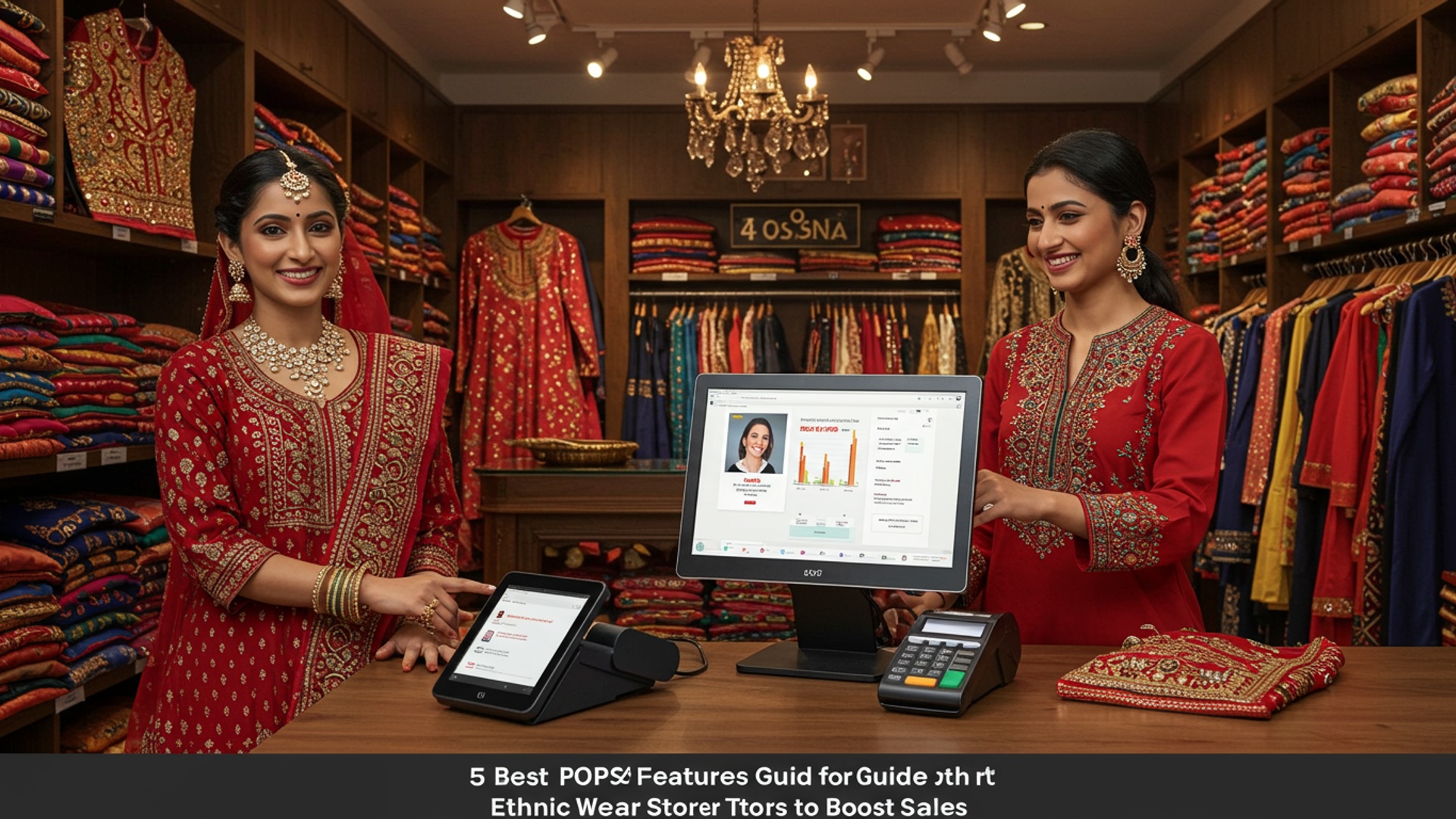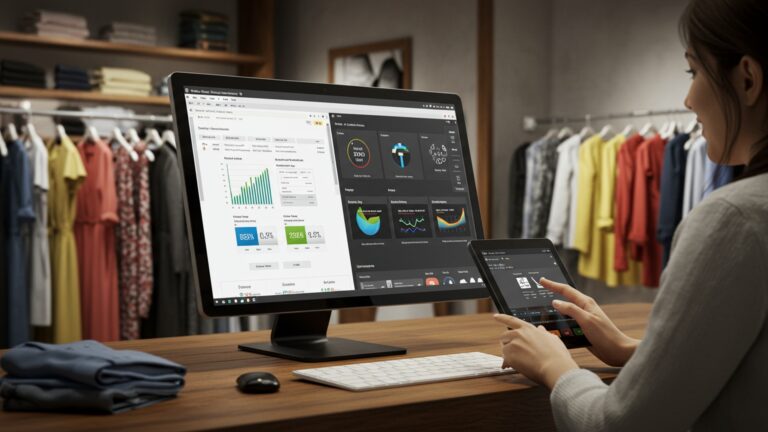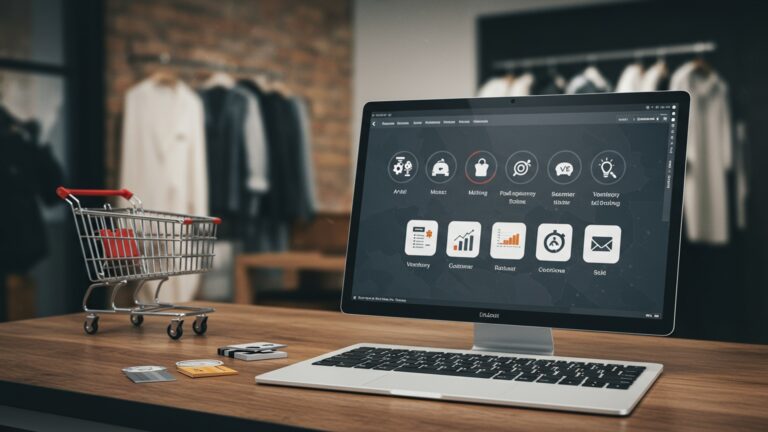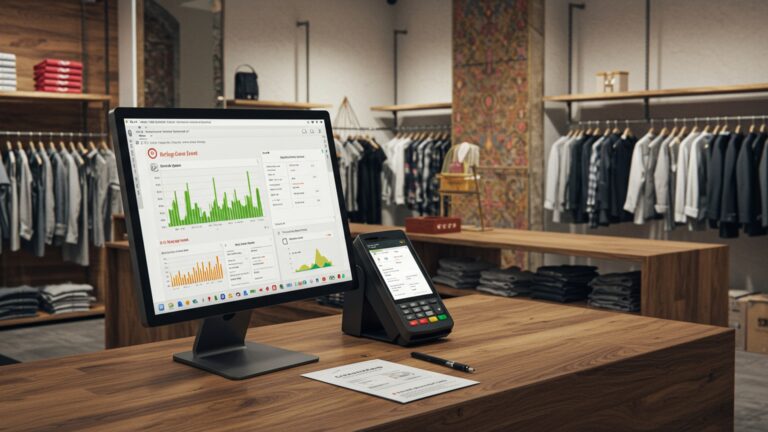5 Best POS Features Guide for Ethnic Wear Stores to Boost Sales
Navigating the vibrant, often intricate world of ethnic wear retail—from managing bespoke lehengas to tracking a seasonal surge in kurta sales—demands more than just traditional cash registers. Modern pos for ethnic wear stores now transcends basic transactions, offering sophisticated tools crucial for retailers competing in today’s dynamic omnichannel market. Savvy businesses leverage cloud-based systems for real-time inventory of varied sizes and intricate designs, personalize customer journeys through integrated loyalty programs. utilize AI-driven analytics to forecast demand for festive collections or regional specialties. These advanced features streamline operations, minimize stockouts of popular designs. ultimately empower stores to significantly elevate customer engagement and boost sales.

Advanced Inventory Management for Diverse Collections
For ethnic wear stores, managing inventory goes far beyond simply counting items. The sheer variety of products—from intricate sarees and lehengas to everyday kurtis and accessories—each with multiple variants in terms of fabric, print, embroidery, size. color, demands an exceptionally robust inventory system. A top-tier pos for ethnic wear stores isn’t just a sales tool; it’s the backbone of your stock control.
What is Advanced Inventory Management?
Advanced inventory management refers to the sophisticated tracking and organization of your store’s stock, enabling real-time visibility and control over every single item. This includes detailed product categorization, variant management, stock level monitoring. automated reorder points.
- Vast SKU Diversity
- Unique & Limited Edition Items
- Variant Tracking
- Cross-Location Inventory
Ethnic wear often means managing hundreds, if not thousands, of unique SKUs. A single saree design might come in five colors, three fabric types. varying border patterns. Without precise tracking, overselling or stockouts are inevitable.
Many ethnic pieces are handmade or part of limited collections. Your POS needs to handle these unique identifiers without confusion.
The ability to track specific attributes like “Chanderi Silk Saree – Royal Blue – Zari Border – Size 6. 5m” is paramount. This level of detail helps customers find exactly what they want and helps you manage replenishment accurately.
If you have multiple branches or a warehouse, a centralized system ensures you know exactly where every item is, making transfers and customer requests seamless.
Imagine a customer walks into your store looking for a specific Banarasi silk saree they saw on your website. With an advanced POS, your sales associate can immediately check if that exact saree (including its specific color, weave. size) is in stock, whether it’s in the back room, or even at another store location. This prevents lost sales and enhances customer satisfaction. Similarly, when a new collection of designer lehengas arrives, the POS can rapidly process and categorize each piece, assigning unique identifiers for easy tracking from arrival to sale.
Prioritize a POS solution that offers deep variant tracking, allowing you to define multiple attributes for each product. Look for features like automated low-stock alerts and integrated vendor management to streamline your purchasing process and ensure your most popular items are always available.
Robust Customer Relationship Management (CRM) & Personalized Loyalty Programs
In the ethnic wear market, customer relationships are paramount. Shoppers often have specific tastes, occasions in mind (weddings, festivals). appreciate a personalized touch. A comprehensive CRM integrated into your pos for ethnic wear stores transforms transactional interactions into lasting relationships, fostering loyalty and repeat business.
What is CRM & Loyalty Programs?
Customer Relationship Management (CRM) involves collecting and analyzing data about your customers’ interactions and history with your store. Loyalty programs are structured initiatives designed to reward repeat customers, encouraging continued engagement and purchases.
- Understanding Preferences
- Personalized Marketing
- Building Community & Trust
- Repeat Business
Ethnic wear is highly personal. A good CRM tracks customer purchase history, preferred styles (e. g. , traditional, contemporary), colors, sizes. even occasions they’ve shopped for.
Instead of generic promotions, you can target customers with offers relevant to their past purchases or known preferences, significantly increasing conversion rates.
Ethnic wear often carries cultural significance. A store that remembers a customer’s specific needs for a family wedding or a festival builds trust and a sense of belonging.
Loyalty programs, such as points systems, tiered rewards, or exclusive access to new collections, incentivize customers to return to your store over competitors.
Consider a customer, Priya, who frequently buys elegant salwar suits for office wear. Her purchase history in your POS CRM clearly shows her preference for subtle prints and breathable fabrics. When a new collection of work-appropriate kurtis arrives, your POS can trigger an automated email or SMS campaign specifically targeting Priya and others with similar preferences, offering them an exclusive preview or discount. Moreover, if Priya is part of your loyalty program, she might accumulate points with each purchase, which she can redeem for her next festive lehenga, making her more likely to return. This personalized approach, powered by a smart pos for ethnic wear stores, drives sales effectively.
Look for a POS system that offers detailed customer profiles, tracks purchase history. supports customizable loyalty programs. Leverage this data to segment your customer base and craft highly targeted marketing campaigns, making every customer feel valued and understood.
Seamless Omnichannel Integration
Today’s ethnic wear customer journey is rarely linear. They might browse Instagram, visit your website, try on an outfit in-store. then purchase online, or vice-versa. An omnichannel approach, facilitated by your POS, provides a unified and consistent shopping experience across all touchpoints, eliminating friction and maximizing sales opportunities.
What is Omnichannel Integration?
Omnichannel integration means providing a seamless and consistent customer experience across all available sales channels, whether physical stores, e-commerce websites, mobile apps, or social media platforms. All channels are connected and share real-time data, primarily driven by the POS system.
- Consistent Inventory
- Flexible Shopping Options
- Unified Customer Profiles
- Expanded Reach
Customers expect to see the same stock availability online as they do in-store. Omnichannel ensures real-time inventory synchronization, preventing frustrating “out of stock” messages after an online order or a wasted trip to the store.
Offer ‘Buy Online, Pick Up In-Store’ (BOPIS) or ‘Ship from Store’ options. This is particularly useful for ethnic wear where customers might want to feel the fabric or try on an item before committing. still appreciate the convenience of online ordering.
A customer’s in-store purchase history, online browsing behavior. loyalty points are all accessible from a single profile, enabling truly personalized service regardless of how they interact with your brand.
Integrate social media selling tools directly with your POS, allowing customers to discover and purchase ethnic wear pieces directly from platforms like Instagram or Facebook.
Consider an ethnic wear store that recently launched a new collection of designer bridal lehengas. A prospective bride, searching online, discovers a piece she loves on your website. She uses the ‘Check In-Store Availability’ feature, powered by your omnichannel POS, to confirm it’s at your nearest branch. She visits the store, tries it on. decides to purchase. The sales associate, using the same pos for ethnic wear stores, can access her online browsing history, apply any online-exclusive discounts she might have. complete the sale. Later, if she needs an alteration, the in-store team can access her original purchase details and measurements from the unified system. This entire journey feels effortless for the customer because all channels are talking to each other.
When selecting a POS, prioritize systems with strong e-commerce and social media integrations. Ensure it can synchronize inventory, customer data. sales across all channels in real-time. This holistic approach is key to capturing sales from today’s multi-platform shopper.
Actionable Sales & Inventory Analytics
Running a successful ethnic wear store isn’t just about selling beautiful garments; it’s about understanding what sells, to whom, when. why. Actionable sales and inventory analytics, provided by a robust POS, transform raw data into powerful insights, enabling you to make informed decisions that directly impact profitability and merchandising strategies.
What are Actionable Sales & Inventory Analytics?
These are comprehensive reports and dashboards generated from your POS data that provide insights into sales performance, inventory movement, customer behavior. employee productivity. The “actionable” aspect means the insights are clear enough to guide specific business decisions.
- Identifying Bestsellers & Slow-Movers
- Understanding Seasonal & Festival Trends
- Optimizing Pricing & Promotions
- Managing Supplier Performance
- Improving Staff Performance
Pinpoint which specific designs, colors, or fabrics of sarees, kurtis, or lehengas are flying off the shelves versus those gathering dust. This helps optimize future purchasing.
Ethnic wear sales are highly seasonal, driven by festivals (Diwali, Eid, Christmas), weddings. cultural events. Analytics can show peak demand periods for specific categories, allowing you to stock up effectively.
assess the effectiveness of past discounts and promotions. Which items responded well to markdowns? Which can command full price?
Track which vendors provide your most profitable or fastest-selling items, informing future sourcing decisions.
Monitor sales by individual staff members to identify training needs or recognize top performers.
A store owner using a sophisticated pos for ethnic wear stores notices through their analytics dashboard that their collection of lightweight cotton kurtis sees a massive surge in sales during the summer months, particularly in vibrant floral prints. Conversely, heavy embroidered lehengas only peak during wedding season (October-February). Armed with this data, the owner decides to significantly increase orders for cotton kurtis in spring, launch targeted summer marketing campaigns for them. scale back on heavy ethnic wear until closer to wedding season. They also identify a particular vendor whose silk dupattas consistently sell out within weeks, prompting them to increase orders from that supplier. These data-driven decisions minimize dead stock and maximize sales opportunities.
Regularly delve into your POS analytics. Don’t just look at total sales; break it down by product category, variant, time of day. even sales associate. Use these insights to refine your inventory purchasing, seasonal marketing. pricing strategies for maximum impact.
Efficient Returns & Exchange Management with Customization Support
Returns and exchanges are an inevitable part of retail. for ethnic wear, the process can be more complex due to the nature of the garments—often involving intricate designs, specific sizing. sometimes custom alterations. A POS that streamlines this process, while also effectively managing customization requests, enhances customer satisfaction and operational efficiency.
What is Efficient Returns & Exchange Management with Customization Support?
This feature refers to the POS system’s ability to quickly and accurately process product returns, issue refunds or store credit. manage exchanges. Also, for ethnic wear, it includes the capability to track and manage custom orders, alterations. special requests from initial order to final delivery.
- Customer Trust & Satisfaction
- Handling Complex Returns
- Managing Alterations & Custom Orders
- Reducing Fraud & Errors
- Store Credit Options
A hassle-free return policy and process build trust. If a customer knows returns are easy, they are more likely to make a purchase.
Ethnic wear can sometimes be delicate, or a customer might return only part of a set (e. g. , a saree but not the blouse). The POS needs to handle partial returns and assign appropriate values.
Many ethnic garments require alterations (e. g. , blouse stitching, lehenga hemming) or are custom-made. Your POS should track the status of these orders, link them to the original sale. notify customers when ready.
A robust POS can quickly verify original purchase details, preventing fraudulent returns and ensuring accurate refunds or exchanges.
Offering store credit for returns can keep the revenue within your business, a valuable option for ethnic wear where customers often return to find another item.
A customer, Aarti, purchases a designer lehenga for a wedding. Upon trying it at home, she realizes the blouse needs a slight alteration. Instead of a manual process, the sales associate, using the pos for ethnic wear stores, can easily log the alteration request, attach it to Aarti’s original purchase. generate a tracking number for the tailoring department. Aarti receives an SMS notification when her altered blouse is ready for pickup. Separately, another customer, Preeti, returns a readymade salwar suit that didn’t fit. The POS instantly pulls up Preeti’s purchase history, verifies the return window. offers her a choice of a refund or store credit. Preeti opts for store credit, which is immediately issued and linked to her customer profile, ensuring she’ll likely return to your store to use it.
Choose a POS system that offers flexible return options (refund, exchange, store credit), can track alterations and custom orders efficiently. integrates these processes seamlessly with customer profiles. A smooth post-purchase experience is just as crucial as the sale itself for building long-term loyalty.
Conclusion
Embracing a modern POS system is no longer a luxury but a strategic imperative for ethnic wear stores aiming to truly thrive. We’ve explored how features like robust inventory management, crucial for tracking unique lehengas and intricate sarees across various sizes and designs, alongside personalized customer profiles that remember every patron’s style preference, directly translate into boosted sales. Think of a recent festival season; without real-time stock updates, missing out on a popular design like a specific Bandhani print or a trending Kutchi embroidery is a lost opportunity. My personal tip? Don’t try to implement everything at once. Start by focusing on the feature that addresses your biggest pain point – perhaps better inventory control to avoid overstocking or stockouts, or streamlining your return process. The ability to quickly process sales via mobile POS during peak hours, or leverage data analytics to predict demand for the next festive collection, empowers you to make smarter, data-driven decisions. This isn’t just about transactions; it’s about building deeper customer relationships and staying agile in a dynamic market. For a deeper dive into essential functionalities, consider exploring Master 7 Essential Features for Clothing Store POS Software India. Take that first step; your store’s future success in the vibrant ethnic wear landscape depends on it.
More Articles
How to Choose the Best Offline POS System for Your Indian Clothing Store
How to Easily Set Up and Use Mobile POS Software for Seamless Sales
Learn How to Choose the Right POS Software for Efficient Retail Operations
7 Essential POS System Benefits for Your Saree Shop Success
Master 7 Essential Features for Clothing Store POS Software India
FAQs
Why is a modern POS system so vital for ethnic wear stores today?
A modern POS isn’t just for processing payments. For ethnic wear, it streamlines operations, helps you interpret customer preferences, manages your unique inventory effectively. ultimately provides tools to enhance the shopping experience and increase your sales.
My ethnic wear stock has so many variations (sizes, colors, designs). How does a POS help manage that?
A good POS with advanced inventory features can track every single variant precisely. You can manage unique SKU numbers for different sizes, colors. patterns, see what’s in stock across locations. even get alerts for low stock on popular items, preventing missed sales.
How can a POS help me build loyalty and get customers to return for more ethnic outfits?
A robust POS includes CRM features that let you capture customer data, track purchase history. run targeted loyalty programs. You can offer personalized discounts, send special occasion greetings, or notify them about new arrivals in their preferred styles, encouraging repeat business.
What kind of sales insights can I get from a POS to boost my ethnic wear sales?
A powerful POS provides detailed sales analytics. You can see which ethnic wear styles, colors. price points are selling best, identify slow-moving inventory, interpret peak shopping times. even track staff performance. These insights help you make informed decisions about merchandising and marketing.
I sell ethnic wear both in my physical store and online. Can a POS connect these two?
Absolutely! An omnichannel-capable POS unifies your online and in-store operations. It ensures real-time inventory updates across all channels, allows customers to buy online and pick up in-store (BOPIS), or vice versa. provides a consistent customer experience regardless of where they shop.
Making returns and exchanges smooth is crucial for customer satisfaction. How does a POS assist with that for ethnic wear?
An efficient POS simplifies the entire returns and exchanges process. It quickly pulls up past transactions, verifies purchase details. processes refunds or exchanges seamlessly. This reduces wait times for customers and ensures accuracy, enhancing their overall experience with your store.
Can a POS help my sales team perform better and ultimately sell more ethnic wear?
Yes, many POS systems offer features for staff management. You can track individual sales performance, calculate commissions accurately. identify top performers. This encourages friendly competition and helps you provide targeted training, leading to a more motivated and effective sales team.






